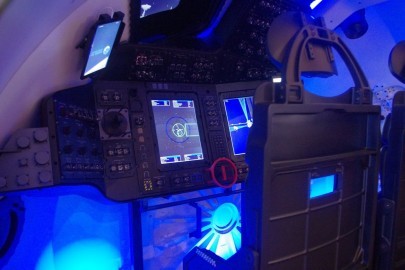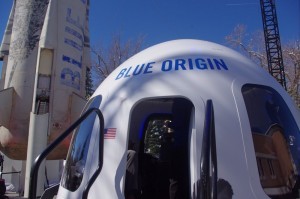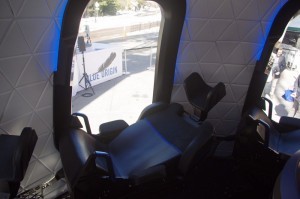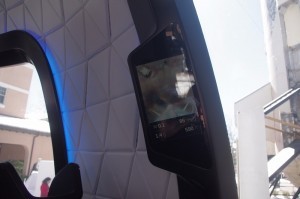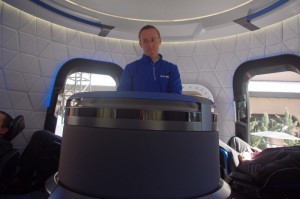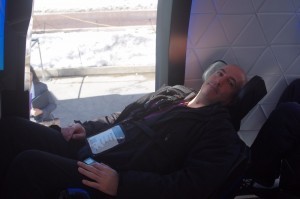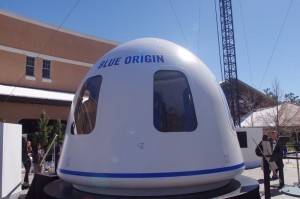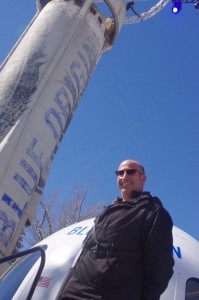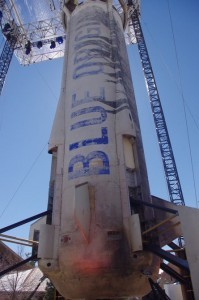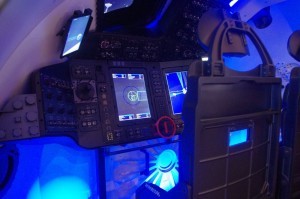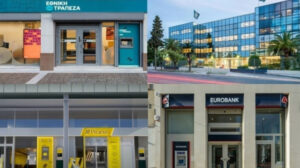The Space Symposium, a four-day gathering of the biggest players in space exploration, touched down in Colorado Springs this week, and New Atlas has been on the ground covering the action. In addition to a series of panel discussions, the event also had some impressive technology on display, most notably the replica of Blue Origin’s space capsule and a simulator for Boeing’s Starliner. We got a chance to check them both out and take a peek at the future of commercial space travel.
Blue Origin
Dominating the outdoor space by the entrance to the conference was the New Shepard rocket and crew capsule designed by Jeff Bezos’ Blue Origin. The plan is for the rocket to carry passengers above the Kármán line, the edge of Earth’s atmosphere, located at a height of 100 km (62 mi), where they can get a glimpse of our planet from a perspective only few have ever enjoyed.
Ascent will take place over the course of two and a half minutes and passengers will experience up to 3 g of force, or three times the force of gravity. Once the capsule reaches its height, passengers are welcome to unbuckle themselves from their seats and enjoy weightlessness for four to five minutes. Then it will be time to strap back in for descent, which will generate just under 5 gs. Descent will be slowed to about 20 mph with a chute system and retrorockets cause deceleration down to 3 mph before touchdown.
Total time from launch to land will be just over 11 minutes and, while there is no word yet on how much a flight will cost, it’s bound to be out of reach for the everyday person. Virgin Galactic’s SpaceShipTwo, for example, is slated to cost US$250,000 per ticket.
The experience I
Entering Blue Origin’s capsule was like stepping into the luxurious cabin of a fine sports car.
Despite being able to seat six people in an area of just 530 cubic-feet along with a rocket stowage capsule designed to provide enough thrust for an escape maneuver should something go wrong with the main rocket, the capsule felt surprisingly spacious. This was largely due to the large windows that take up a full third of the entire capsule and let in 92 percent of visible light.
The leather seats are arranged in prone positions around the outer edge of the capsule and were extremely comfortable. Even though you’re mostly lying down, there is a slight upward angling that puts you in the perfect position to see out your private window. Also in easy view is a small tablet-style screen that will detail the trip and tell you when to unbuckle and strap back up, as the autonomous journey will not be manned by a Blue Origin crew member. If you are going to travel to space, believe us, this is the way you’d want to do it.
Starliner
With a cutaway version of its capsule and a simulated version of the cockpit, Boeing’s offering in the commercial space transit arena, the Starliner, wasn’t quite as far along as Blue Origin’s, but then again, it’s a more ambitious project.
The Starliner is being designed to take passengers higher than the Blue Origin capsule – all the way into low-Earth orbit or straight to the International Space Station (ISS). The capsule will be able to hold seven passengers for space tourism purposes or, when heading to the ISS, it will hold four crew members in addition to cargo.
The Starliner is due for pad abort testing in White Sands, New Mexico next year to test the ability of the capsule to escape the Atlas V rocket that will carry it to space, followed by both un-crewed and crewed tests in the same year.
The experience II
The Starliner simulator was like playing a kind of boring video game in an airplane cockpit.
“We’re going to be flying the CST-100 spacecraft to a docking with the International Space Station at Node 2 forward,” said Dan Nelson, a guidance navigation control engineer for Boeing. “So we’re going to be flying down this imaginary cone here extending from the docking port that’s called the docking corridor. We want to be moving down this corridor fast enough that the docking clamps engage at the end, but not so fast that we break hardware and NASA sends us a huge bill. The rate we want to be going is between 0.03 and 0.06 meters per second.”
While that all sounded pretty intimidating, the process actually just involved using a small joystick that controlled direction with a rocker switch on top for thrust. Thanks to Nelson’s instruction, the docking maneuver took just about three minutes and was fairly uneventful. While it didn’t make for the most thrilling experience, when you’re trying to attach to a space station whizzing around the planet at just under five miles per second, uneventful is exactly what you’re looking for.
Also included as part of the Boeing exhibit was the lightweight spacesuit travelers on the Starliner will need to don. That suit, in addition to many other pieces of space tech will be highlighted in our forthcoming gallery from the show floor.
Ask me anything
Explore related questions
